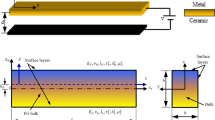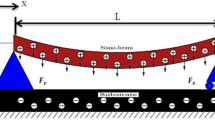Abstract
In this paper, the nonlinear static responses of curled cantilever micro-/nanobeams are investigated. The beams are subjected to a one-sided electrostatic actuation, and the effects of both fringing field and van der Waals force are also included. Based on the combination of the Galerkin method and the choice of the shape function of the beam deformation, the analytical approximate solutions are established. The Pull-In voltages which determine the stability of the curled beam actuators are also obtained. When van der Waals force is neglected, the Pull-In parameters are explicitly presented. These approximate solutions show excellent agreements with numerical solutions obtained by the shooting method and the experimental data for a wide range of beam length. Expressions of these analytical approximate solutions are brief and could easily be used to derive the effects of various factors, such as fringing field, van der Waals force, the width of the beam and the gap, on micro-/nanobeams.









Similar content being viewed by others
References
Abdulla SMC, Yagubizade H, Krijnen GJM (2012) Analysis of resonance frequency and pull-in voltages of curled micro-bimorph cantilevers. J Micromech Microeng 22(3):035014
Ansari R, Gholami R, Shojaei MF, Mohammadi V, Sahmani S (2015) Bending, buckling and free vibration analysis of size-dependent functionally graded circular/annular microplates based on the modified strain gradient elasticity theory. Eur J Mech A Solids 49:251–267
Ardito R, Corigliano A, Frangi A (2013) Modelling of spontaneous adhesion phenomena in micro-electro-mechanical systems. Eur J Mech A Solids 39:144–152
Batra RC, Porfiri M, Spinello D (2008) Reduced-order models for micro-electromechanical rectangular and circular plates incorporating the Casimir force. Int J Solids Struct 45:3558–3583
Bell DJ, Lu TJ, Fleck NA, Spearing SM (2005) MEMS actuators and sensors: observations on their performance and selection for purpose. J Micromech Microeng 15(7):S153–S164
Bergers LIJC, Hoefnagels JPM, Geers MGD (2014) Characterization of time-dependent anelastic microbeam bending mechanics. J Phys D Appl Phys 47(35):355306
Bergström L (1997) Hamaker constants of inorganic materials. Adv Colloid Interface 70(1–3):125–169
Bhushan B, Agrawal GB (2002) Stress analysis of nanostructures using a finite element method. Nanotechnology 13(4):515–523
Buhmann SY (2012) Dispersion forces I: Macroscopic quantum electrodynamics and ground-state Casimir, Casimir–Polder and van der Waals Forces. Springer, Berlin
Buks E, Roukes ML (2001) Stiction, adhesion energy, and the Casimir effect in micromechanical systems. Phys Rev B 63(3):033402
Carcaterra A (2014) Quantum Euler beam—QUEB: modeling nanobeams vibration. Contin Mech Thermodyn 27(1–2):145–156
Casimir HBG (1948) On the attraction between two perfectly conducting plates. Proc K Ned Akad Wet 51:793–795
Chowdhery S, Ahmadi M, Miller WC (2005) A closed form model for the Pull-In voltage of electrostatically actuated cantilever beams. J Micromech Microeng 15:756–763
Chuang WC, Lee HL, Chang PZ, Hu YC (2010) Review on the modeling of electrostatic MEMS. Sensors 10:6149–6171
Corigliano A, Pugno NM (2013) Micro- or nano-mechanics. Meccanica 48:1817–1818
Corigliano A, Ghisi A, Langfelder G, Longoni A, Zaraga F, Merassi A (2011) A microsystem for the fracture characterization of polysilicon at the micro-scale. Eur J Mech A Solids 30(2):127–136
DelRio FW, de Boer MP, Knapp JA, Reedy ED, Clews PJ, Dunn ML (2005) The role of van der Waals forces in adhesion of micromachined surfaces. Nat Mater 4(8):629–634
Duan JS, Rach R, Wazwaz AM (2013) Solution of the model of beam-type micro- and nano-scale electrostatic actuators by a new modified Adomian decomposition method for nonlinear boundary value problems. Int J Nonlinear Mech 49:159–169
Elata D, Abu-Salih S (2005) Analysis of a novel method for measuring residual stress in micro-systems. J Micromech Microeng 15:921–927
Espinosa HD, Zhu Y, Fischer M, Hutchinson J (2003) An experimental/computational approach to identify moduli and residual stress in MEMS radio-frequency switches. Exp Mech 43(3):309–316
Fang W, Wickert JA (1994) Post buckling of micromachined beams. J Micromech Microeng 4:116–122
Gupta RK (1997) Electrostatic Pull-In test structure design for in situ mechanical property measurements of microelectromechanical systems (MEMS). Ph.D. dissertation, Massachusetts Institute of Technology
Gutschmidt S (2010) The Influence of higher-order mode shapes for reduced-order models of electrostatically actuated microbeams. ASME J Appl Mech 77:041007
Hamaker HC (1937) The London—van der Waals attraction between spherical particles. Physica 4(10):1058–1072
Hesketh PJ (2011) BioNanoFluidic MEMS. Springer, New York
Hess AE, Capadona JR, Shanmuganathan K, Hsu L, Rowan SJ, Weder C, Tyler DJ, Zorman CA (2011) Development of a stimuli-responsive polymer nanocomposite toward biologically optimized, MEMS-based neural probes. J Micromech Microeng 21:054009
Hu YC (2006) Closed form solutions for the pull-in voltage of micro curled beams subjected to electrostatic loads. J Micromech Microeng 16:648–655
Hu YC, Wei CS (2007) An analytical model considering the fringing fields for calculating the pull-in voltage of micro curled cantilever beams. J Micromech Microeng 17:61–67
Jia XL, Yang J, Kitipornchai S (2011) Pull-in instability of geometrically nonlinear micro-switches under electrostatic and Casmir forces. Acta Mech 218(1–2):161–174
Karamooz Ravari MR, Talebi S, Shahidi AR (2014) Analysis of the buckling of rectangular nanoplates by use of finite-difference method. Meccanica 49:1443–1455
Kazama A, Aono T, Okada R (2013) Stress relaxation mechanism with a ring-shaped beam for a piezoresistive three-axis accelerometer. J Microelectromech Syst 22:386–394
Krylov S (2007) Lyapunov exponents as a criterion for the dynamic pull-in instability of electrostatically actuated microstructures. Int J Non Linear Mech 42:626–642
Li XD, Bhushan B (2002) A review of nanoindentation continuous stiffness measurement technique and its applications. Mater Charact 48(1):11–36
Li YL, Meguid SA, Fu YM, Xu DL (2014) Nonlinear analysis of thermally and electrically actuated functionally graded material microbeam. Proc R Soc A Math Phys 470(2162):20130473
Lueke J, Rezaei M, Moussa WA (2014) Investigation of folded spring structures for vibration-based piezoelectric energy harvesting. J Micromech Microeng 24(12):125011
Mariani S, Ghisi A, Corigliano A, Zerbini S (2007) Multi-scale analysis of MEMS sensors subject to drop impacts. Sensors 7(9):1817–1833
Moeenfard H, Darvishian A, Ahmadian MT (2013) A coupled bending-torsion model for electrostatically actuated torsional nano/micro-actuators with considering influence of van der Waals force. Acta Mech 224:1791–1800
Mojahedi M, Moeenfard H, Ahmadian MT (2009) A new efficient approach for modeling and simulation of nano-switches under the combined effect of intermolecular surface forces and electrostatic actuation. Int J Appl Mech 1(2):349–365
Mojahedi M, Ahmadian MT, Firoozbakhsh K (2014) Effects of Casimir and van der Waals forces on the pull-in instability of the nonlinear micro and nano-bridge gyroscopes. Int J Struct Stab Dyn 14(2):1350059
Nasedkin AV, Eremeyev VA (2014) Harmonic vibrations of nanosized piezoelectric bodies with surface effects. ZAMM J Appl Math Mech/Zeitschrift für Angewandte Mathematik und Mechanik 94(10):878–892
Noghrehabadi A, Ghalambaz M, Ghanbarzadeh A (2012) A new approach to the electrostatic pull-in instability of nanocantilever actuators using the ADM-Pade technique. Comput Math Appl 64(9):2806–2815
Ou KS, Chen KS, Yang TS, Lee SY (2011) A novel semianalytical approach for finding pull-in voltages of micro cantilever beams subjected to electrostatic loads and residual stress gradients. J Microelectromech Syst 20(2):527–537
Park H, Park J, Park J (2013) A curled PZT cantilever based MEMS harvester. IEEE - ISAF/PFM, Prague
Ramezani A, Alasty A, Akbari J (2007) Closed-form solutions of the pull-in instability in nano-cantilevers under electrostatic and intermolecular surface forces. Int J Solids Struct 44:4925–4941
Sabate N, Vogel D, Gollhardt A, Keller J, Cane C, Gracia I, Morante JR, Michel B (2007) Residual stress measurement on a MEMS structure with high-spatial resolution. J Microelectromech Syst 16(2):365–372
Scott S, Kim JI, Sadeghi F, Peroulis D (2012) An analytical capacitance model of temperature-sensitive, large-displacement multimorph cantilevers: numerical and experimental validation. J Microelectromech Syst 21(1):161–170
Shames IH, Dym CL (1985) Energy and finite element methods in structural mechanics. McGraw-Hill, New York
Small J, Irshad W, Fruehling A, Garg A, Liu X, Peroulis D (2012) Electrostatic fringing-field actuation for pull-in free RF-MEMS analogue tunable resonators. J Micromech Microeng 22:095004
Soroush R, Koochi A, Kazemi AS, Noghrehabadi A, Haddadpour H, Abadyan M (2010) Investigating the effect of Casimir and van der Waals attractions on the electrostatic pull-in instability of nano-actuators. Phys Scr 82:045801
Sundararajan S, Bhushan B (2002) Development of AFM-based techniques to measure mechanical properties of nanoscale structures. Sensor Actuators A Phys 101(3):338–351
Timoshenko SP, Gere JM (1961) Theory of elastic stability. McGrawHill-Kogakusha Ltd, Tokyo
Wei LC, Mohammad AB, Kassim NM (2002) Analytical modeling for determination of pull-in voltage for an electrostatic actuated MEMS cantilever beam. In: Proceedings of IEEE ISCE 2002
Wunderle B, Michel B (2009) Lifetime modelling for microsystems integration: from nano to systems. Microsyst Technol 15(6):799–812
Xiang HJ, Shi ZF (2009) Static analysis of functionally graded piezoelectric actuators or sensors under a combined electro-thermal load. Eur J Mech A Solids 28:338–346
Younis MI, Abdel-Rahman EM, Nayfeh AH (2003) A reduced-order model for electrically actuated microbeam-based mems. J Microelectromech Syst 12:672–680
Yu YP, Wu BS, Lim CW (2012) Numerical and analytical approximations to large post-buckling deformation of MEMS. Int J Mech Sci 55:95–103
Zhang ZQ, Liao XP (2013) A lumped model with phase analysis for inline RF MEMS power sensor applications. Sensors Actuators A Phys 194(1):204–211
Zhang LX, Zhao YP (2003) Electromechanical model of RF MEMS switches. Microsyst Technol 9(6–7):420–426
Zhang Y, Zhao YP (2006) Numerical and analytical study on the pull-in instability of micro-structure under electrostatic loading. Sensor Actuators A Phys 127:366–380
Acknowledgments
The work described in this paper is supported by SinoProbe-09-05 (Grant No. 201011082), the National Natural Science Foundation of China (Grant No. 11402095), and the Science and Technology Developing Plan Project of Jilin Province (Grant No. 20160520021JH).
Author information
Authors and Affiliations
Corresponding author
Appendix
Appendix
Rights and permissions
About this article
Cite this article
Sun, Y., Yu, Y., Wu, B. et al. Closed form solutions for nonlinear static response of curled cantilever micro-/nanobeams including both the fringing field and van der Waals force effect. Microsyst Technol 23, 163–174 (2017). https://doi.org/10.1007/s00542-016-2870-y
Received:
Accepted:
Published:
Issue Date:
DOI: https://doi.org/10.1007/s00542-016-2870-y




